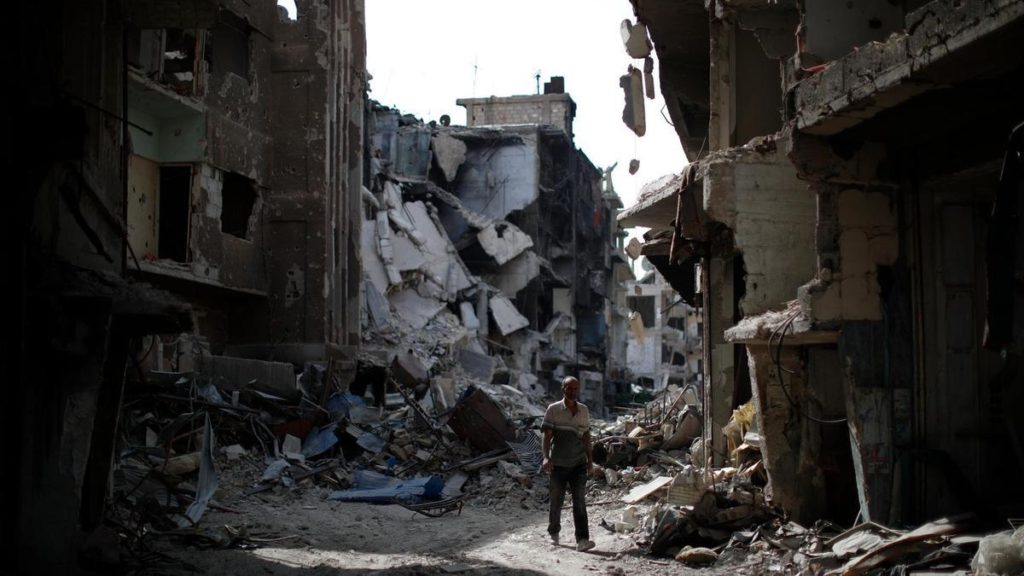The “Action Group for the Palestinians of Syria (AGPS)” said that Damascus governor, Adel al-Olabi, had a meeting with the legal and technical committee designated to study the Yarmouk camp’s regulatory plan, following the governorate’s decision to hold off the implementation of the plan, after thousands of objections from the residents of the camp.
On 8 September, the AGPS quoted private sources without naming them, saying that the governor of Damascus met on 6 September members of the committee designated to study the new master plan of the Yarmouk camp. This committee was formed in consultation between Damascus governorate and the “General Authority for Palestinian Arab Refugees” (GAPAR).
The sources added that the meeting outcomes were not declared and added that the discussion would be completed in another meeting set by the committee to take the appropriate measures.
This comes within the continuation of the Yarmouk camp residents’ demands to return to their real properties and end their living and economic sufferings.
Damascus governorate decided to hold off the issuance of the Yarmouk camp’s final regulatory plan and formed a committee in this regard after thousands of objections were submitted by the camp residents.
According to a decision issued by the governorate last August, Damascus governor, Adel al-Olabi, ordered the formation of a committee, headed by himself and two governorate directors, and the head of the Yarmouk camp’s services department, Rula Mawed.
This committee aimed at studying the issue of the Yarmouk camp after issuing the suspension decision of its regulatory plan. It was also designed to discuss the future solutions for the area.
Last June, Damascus governorate announced its approval of the al-Qaboun area’s regulatory plan and the Yarmouk Camp’s regulatory map in Damascus.
Nevertheless, the Yarmouk Camp’s master plan was rejected by the Palestinians of Syria, amid calls from Palestinian human rights organizations for the Damascus governorate to retract the plan, as it is seen as a complete change for the camp’s features.
Palestinian lawyer, Nour Eddin Salman, who lives in Damascus, published on his “Facebook” page that the number of objections submitted by the camp’s residents on the plan has reached more than ten thousand objections.
The United Nations Relief and Works Agency for Palestine Refugees in the Near East (UNRWA) predicted in its report the “Emergency Appeal 2020” that most of the Yarmouk Camp’s population (between 500,000 and 600,000 persons, of which 160,000 are Palestinian refugees) would remain in displacement.
The report also pointed out the limited access to the camp and the enormous magnitude of destruction there.
According to the UNRWA’s statistics, 91 percent of the Palestinian refugee families in Syria live in absolute poverty, of whom 80 percent rely on UNRWA’s cash assistance as their primary source of income.
The camp experienced battles between the factions of the former “Free Syrian Army (FSA)” and the Syrian regime forces, amid the division of the Palestinian factions between the two sides before the so-called Islamic State (IS) took control of two-thirds of the camp in 2015.
However, in May 2018, after a month-long military operation, during which the IS group was expelled from the camp, the forces of the regime completely re-established control over al-Hajar al-Aswad and the Yarmouk camp, in the wake of an unofficial evacuation agreement that transferred the IS group’s members to the desert of As-Suwayda.
According to the “Syrian Cities Damage Atlas,” report issued by the United Nations Institute for Training and Research (UNITAR) in cooperation with the REACH initiative, the Yarmouk Camp was classified as the seventh most destroyed area in Syria.
The military clashes destroyed more than 60 percent of the buildings and infrastructure in the Yarmouk Camp, according to the UNITAR.











